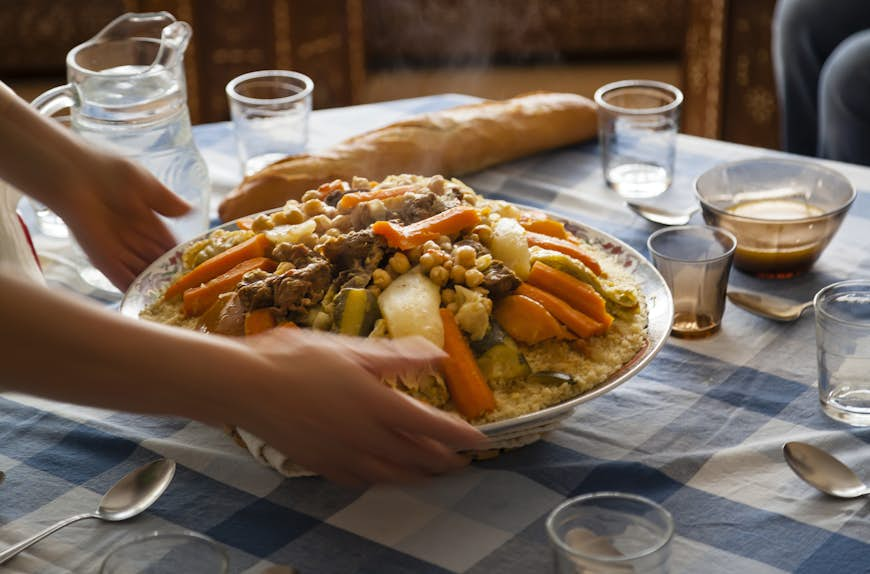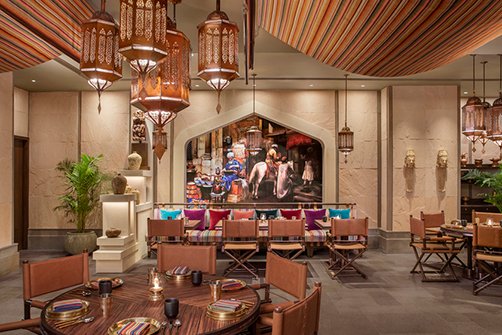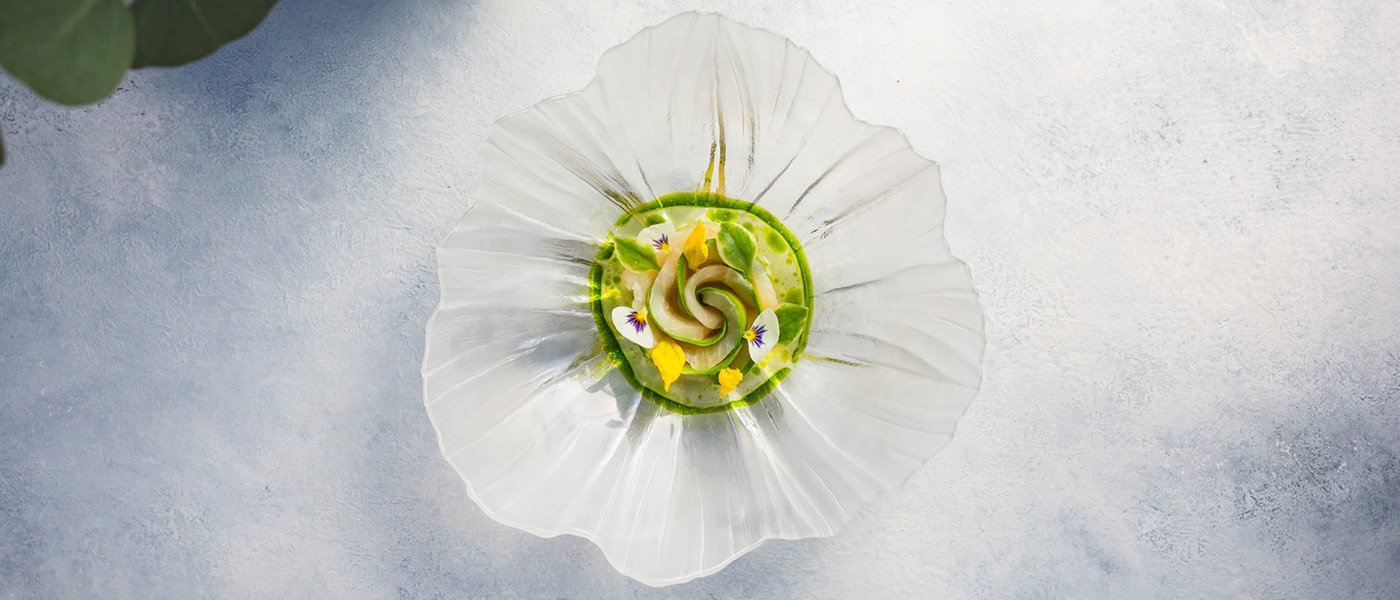There’s a lot more to Moroccan cuisine than couscous and tajines. From cooked vegetable salads and slow-cooked meats to fresh fruits and flaky pastries, the traditional foods of Morocco are mouth-watering.
Midrange restaurant menus can often repeat the same old tajines, so to get more variety you need to feast on street food or dine at one of the growing number of creative fusion restaurants. Home-cooked food is also some of the best in the country, so eating at your riad (guesthouse) can be another good option. Here are the best things to eat and drink in Morocco.

Find time to try a tajine
The quintessential Moroccan dish is a stew cooked in a conical earthenware pot that keeps the ingredients exceptionally moist and tender. The most common tajines are chicken with preserved lemons and green olives, lamb or beef with prunes, and kefta (spiced meatballs of ground lamb and/or beef) interspersed with eggs in a zesty tomato sauce.
Where to try it: Dar Hatim, Fez.
Bite into a brochette from a street stall
Moroccan kebabs are a firm favorite, rubbed with salt and spices, grilled on a skewer, and served with khobz (flatbread) and harissa (hot chili paste), cumin, and salt. Among the most popular varieties are lamb, chicken, kefta, and the flavorful ‘mixed meat’ (usually lamb or beef plus heart, kidney, and liver).
Where to try it: Djembe El Fna Food Stalls, Marrakesh.

Savor Morocco’s national dish, couscous
Morocco’s national dish – aka seksu – is traditionally served on Fridays; although some restaurants now dish it up every day of the week. The age-old process is time-consuming: durum wheat is ground into fine granules and then rolled by hand. Salted water and flour are added, after which it can take up to five hours to steam to light and fluffy perfection.
Couscous is served with an array of vegetables – seksu bedawi, hailing from Casablanca, includes cabbage, carrots, courgettes, onions, potatoes, pumpkin, and squash – or a mix of meat or chicken and vegetables, all accompanied by a flavorsome broth that soaks into the couscous.
Where to try it: Al Mounia, Casablanca.
Scoff down some slow-cooked tanjia
This Marrakesh dish has been dubbed the bachelor’s dish, as it was originally cooked by single men who would put chunks of meat, onions, preserved lemon, garlic, and cumin into a terracotta pot and take it to the local communal oven or hammam to slow cook in the hot coals. Nowadays, it’s a dish that everyone should try in Morocco.
Where to try it: Hadj Mustapha, Marrakesh.
Treat yourself to cornes de gazelle
Literally translating to gazelle horns, these small crescent-shaped cookies stuffed with almond paste and laced with orange-flower water are found across Morocco, and best served with a piping-hot cup of “Berber whiskey” AKA mint tea.
Where to try it: Pâtisserie Bennis Habous, Casablanca

Chow down on bastilla
A Fassi specialty, though now found across the country, this savory-sweet pie is made up of wafer-thin warqa (filo-like pastry) traditionally stuffed with pigeon, chicken, or vegetables as well as caramelized onions, lemon, eggs, and toasted sugared almonds – and then dusted with cinnamon and powdered sugar.
Where to try it: Ruined Garden, Fez (booking essential).
Don’t miss melt-in-the-mouth mechoui
This traditional Moroccan dish consists of a whole lamb, marinated with spices and slow-roasted for hours in an underground oven until it falls off the bone and melts in the mouth. Perfect for groups in restaurants, although it’s possible to get a smaller portion from street stalls.
Where to try it: Mechoui Alley, Marrakesh.
Slurp up some budget-friendly bissara
This thick fava bean or broad bean soup is especially popular for breakfast, topped with a generous drizzle of olive oil, a sprinkling of cumin, and a freshly baked khobz (flatbread). It’s also often a filling, affordable option costing little more than a few dirhams.
Where to try it: Baissara Ansar, Chefchaouen.
Enjoy a refreshing maghrebi mint tea
This refreshing drink, affectionately nicknamed Berber whiskey, is ubiquitous across Morocco. Combining steeped green tea with a handful of fresh nana mint leaves (spearmint) and sugar, you’ll be offered some when you arrive at your riad (guesthouse) or you’re invited as a guest into someone’s home. Small tea shops are often found in the souks, too.
Where to try it: Pâtisserie Driss, Essaouira.
Vegetarians and vegans
Despite the camel spleen sausages, sheep’s-head soup, and other nose-to-tail eating options, Morocco offers plenty of vegetarian and vegan options. Dried fruit, nuts, and olives from the souq are solid snack options or grab some goat cheese with just-baked khobz (bread).
If you’re eating and drinking out in Morocco, you can load up on pastries, pancakes, fresh fruit, and fresh-squeezed juice for breakfast. Bissara is a delicious bean soup that’s typically meat-free, but steer clear of bubbling roadside vats – they may contain snails or sheep’s-head soup.
At lunch, try the mezze of salads, which come with fresh bread and may range from delicate cucumbers in orange-blossom water to substantial herbed beets laced with kaffir lime. Vegetarians can sometimes, but not always, order a vegetable tajine or couscous with seven vegetables — call ahead if you can. Pizza is another widely available and inexpensive vegetarian option, best when topped with local herbs and olives.

Foods worth trying
Nothing goes to waste in Morocco and those with a strong stomach should try these popular dishes, available from markets and food stalls across the country.
Snail soup Pluck the earthy-tasting snails from their shells and then drink the flavorsome broth or opt for the broth sans snails; this mix of more than 10 spices is reputedly good for your digestive system.
Camel spleen Think more camel sausage. The spleen is stuffed with camel meat, spices, and hump fat and then baked, sliced, grilled, and served up in a gamey-tasting sandwich.
Sheep’s head Watching a sheep’s head being charred over hot coals isn’t for the squeamish, but Moroccans have their favorite parts, perhaps a soft chunk of the cheek. The brain is probably bubbling away in a rich sauce nearby.
A year in food
Morocco is the archetypal Slow Food destination, and there’s never a bad time to visit. Its myriad fruits and vegetables are often bound for Europe, but head to any medina market to find local, seasonal produce piled high on market stalls and wooden carts.
Spring (March–May)
It’s time for avocados, apricots, and oranges, as well as strawberries, delicious in fresh juices.
Summer (June–August)
Fruits, such as watermelon, tomatoes, peaches, figs, grapes, and prickly pear have ripened, and mid-June brings the Cherry Festival in Sefrou.
Autumn (September–November)
Autumn sees grapes and pomegranates (mentioned in the Quran as being one of the fruits of paradise), along with the date harvest – it’s said that Morocco has more than 100 varieties.
Winter (December–February)
The cooler months bring clementines, onions, beetroots, carrots, and potatoes, as well as omnipresent oranges.
Eating during Ramadan
During Ramadan, most Moroccans observe the fast during the day, eating only before sunrise and after sunset. Dinner is eaten later than usual, and many wake up early for a filling breakfast before dawn.
Although you will not be expected to observe the fast, eating in public is still frowned upon. Hence many restaurants are closed during the day until iftar, the evening meal when the fast is broken – though if you call ahead to restaurants in tourist areas, you may have luck. Plan ahead: load up on snacks in the market to eat indoors, make arrangements for breakfast or lunch in the privacy of your guesthouse and ask locals about a good place to enjoy iftar.

